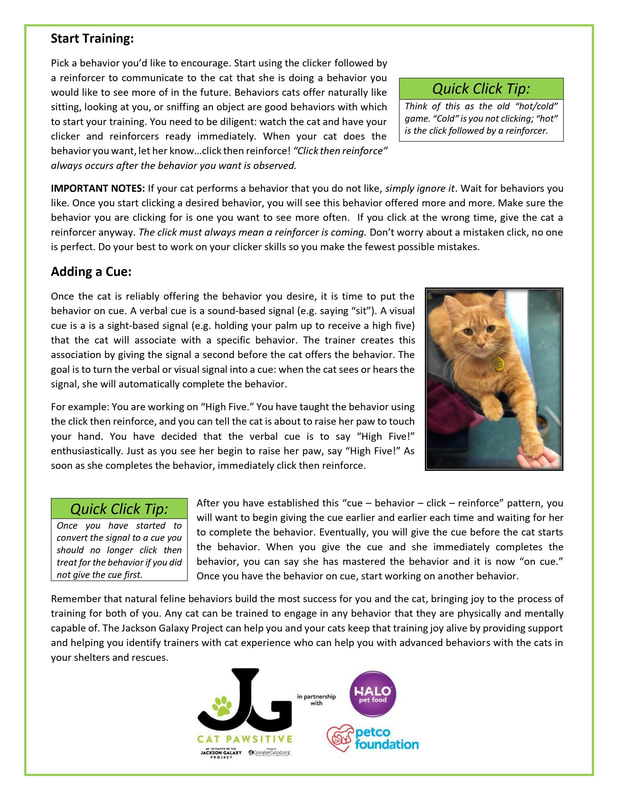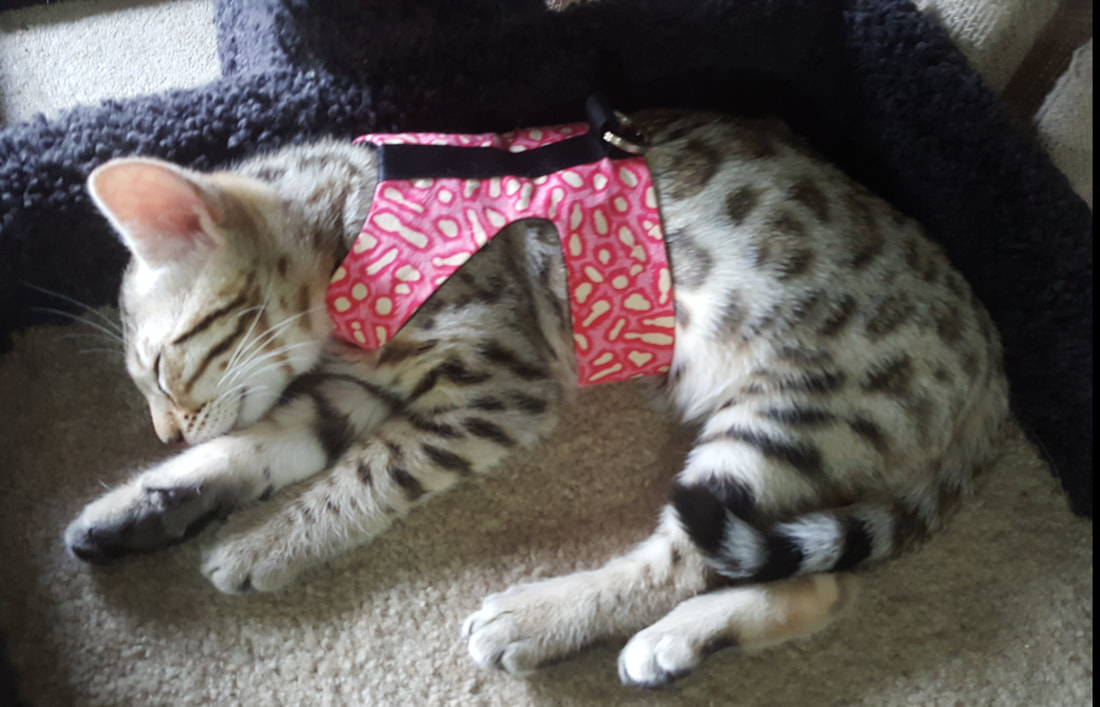- Welcome to Jewelspride Bengals
- SHOP
- Jewelspride Designs
- Life is Better With Bengals - Blog Articles
-
KITTENS
- Links
- SHOP
- Bengal Care - Everything You Need to Know
- About Us
- Catios and Cat Posts!
- Cat Boarding!
- ** Queens **
- ** Studs **
- Our Cattery and Visits
- Cat Wheels
- **NEW** Jewelspride Alumni
- Photo Gallery & Videos
- Uno's World
- Contact Us
- *New! Cat TV!*
- New Page
- Custom Gifts by Carmen
Harness & Leash Training Your Cat
Written by Carmen Klassen, Jewelpsride Bengals
Below: Clicker Training Basics
You can purchase a clicker on Amazon for under $10, or you can simply use a click-top pen for the same results.
I've got my kitten harness, now what?

So, you've got your new kitten home with you and you're very excited to start doing all of the fun things that attracted you to bengals in the first place: taking him on car rides, and out for walks on his leash! We send each of our kittens home with a complimentary voucher for their very own walking harness in order to encourage everyone to give it a try. There are some important steps to follow prior to attempting these activities. You can "make" or "break" your kitten's fondness for his harness and for these activities, depending on how you undertake his introduction to them.
Wearing the Harness
Wearing the Harness
There is definitely a procedure to follow however, to ensure that he takes kindly to the harness right from the start. We highly recommend following Jackson Galaxy's suggestions set out in his video (above) using the clicker training/reward system to get started and familiarize your kitten with the harness before heading outdoors for a walk. Please read through the clicker training technique and take a few minutes to watch the video from start to finish. The first step is to train your kitten to feel comfortable in his harness in the comfort of your home. This is done using Jackson's method of clicker training and by placing the harness securely on your kitten and supervising him as he wanders around the house and gets used to the feel of it. At first he may seem wary, may try to struggle out of it, and may even "tip" over, appearing to be immobilized by it! This is completely normal - it feels weird to him - almost like he's been put into a straight jacket. Give him time to get used to the feel of it. We have found that the best way to do this is to distract him with play - wave his feather teaser wand and encourage him to walk and play while wearing the harness as he normally would. Once he begins to play he will soon forget that he is even wearing the harness. Leave the harness on him for about a half an hour at a time - while he is closely supervised. This should be done a couple of times a day over the course of a few days prior to attaching the leash and attempting t walk around the house with him on it.
Once he is fully comfortable with the harness and is accustomed to walking in the house with you on his leash, you will know the time is right to take the next step.
Remember, not ALL cats need to go outside

Don't pressure your cat to use a harness or go outside for that matter, if he or she doesn't seem interested. Not all cats WANT or NEED to go outdoors, so read your cat's signals and only do it if it seems like fun for them.
The first rule for heading outdoors with your kitten is always carry the kitten out the door rather than walk him out. Walking the kitten out through the door teaches him how to walk out and may encourage escape attempts - or door dashing, as we fondly refer to it. Hold your kitten close with his harness fitted securely on him and his leash held firmly in your free hand. Pet and talk to him and cuddle him as you walk out the door with him. This will offer him encouragement and help him to feel secure. When you get outside with him crouch down to his level and allow him to leave your arms rather than you setting him down. This will help him build up his confidence and not feel like you are deserting him. He needs your reassurance that it's safe and fun and nothing scary is going to happen.
The first rule for heading outdoors with your kitten is always carry the kitten out the door rather than walk him out. Walking the kitten out through the door teaches him how to walk out and may encourage escape attempts - or door dashing, as we fondly refer to it. Hold your kitten close with his harness fitted securely on him and his leash held firmly in your free hand. Pet and talk to him and cuddle him as you walk out the door with him. This will offer him encouragement and help him to feel secure. When you get outside with him crouch down to his level and allow him to leave your arms rather than you setting him down. This will help him build up his confidence and not feel like you are deserting him. He needs your reassurance that it's safe and fun and nothing scary is going to happen.
Cats are NOT dogs...
REMEMBER, cats are not dogs, and they do not walk on a leash like a dog. Be prepared for your cat to take YOU on a walk. And you need to be OK with that. The purpose is for adventure and fresh air. It's not about you... Let him sniff and explore while you simply focus on keeping him untangled (!). We recommend a retractable leash to allow for some length of leash for free roaming during this first phase of leash training. After a few exploratory trips out of doors, you can embark on attempting to train your kitten to walk along side of you, but this is not always possible, and should not be the primary goal or you will become frustrated beyond belief and lose focus of the main intent. For the moment the goal is to focus on getting your kitten outside for some exploration and perhaps ready to travel in the car to more exciting locations for walks.
HUGE TIP: For the first several (if not all) trips outdoors for a "walk" with your kitten, consider wearing a cat carrier back pack or bringing a soft carrier along for the walk. This will prove INVALUABLE if your kitten is spooked or overwhelmed at some point during the walk and you need to quickly get him into a safe place to contain and calm him until you are able to get back home or to your car.
HUGE TIP: For the first several (if not all) trips outdoors for a "walk" with your kitten, consider wearing a cat carrier back pack or bringing a soft carrier along for the walk. This will prove INVALUABLE if your kitten is spooked or overwhelmed at some point during the walk and you need to quickly get him into a safe place to contain and calm him until you are able to get back home or to your car.
Car Rides

Often times a car ride is necessary in order to get to a location where you can walk your kitten - a park, or a pet friendly neighbourhood with lots of walking paths, etc. You've probably had the chance to get a good feel for how your kitten reacts to car rides from your initial car ride home from our house when you came to pick him up! If your kitten was ok with the car ride (ie did not screech or cry the whole ride home) then congratulations, you are blessed and will have a much easier time teaching him to enjoy travelling than is typical. The more typical scenario is that your kitten probably cried during the entire car ride home and you had to talk him through the adventure and provide lots of distraction and reassurance the entire trip. This is all completely normal. It will take many car rides with your kitten to desensitize him to the unusual stress of it. Always keep the harness and leash on your kitten while in the car (if he is not otherwise safely contained in his pet carrier) and have a second person riding in the car with you who is free to supervise the kitten and help him feel comfortable during the ride. This will help ensure that he doesn't get underfoot - talk about distracted driving!!!
There are also some other things you can try which will help alleviate his stress during the car ride. One of those things is the use of an all natural product called Zylkene. You can pick this up from your vet or on Amazon. It's usually a little bit less expensive at the vet and the vet can ensure you are giving a correct dosage. Give this to him for the first little while during the car training endeavor as it will help to alleviate some of his stress and allow him to more calmly take in the adventure and fun of the car ride. Bengals are by nature open to new and exciting adventures and once your kitten's stress level is lowered, this will allow his natural sense of adventure to kick in so he can enjoy the process more.
Zylkene is an all natural milk protein and is not harmful or addictive in any way - it's more like a supplement. It helps a TON. We use it for airline travelling and car trips with our cats when we go to shows or on vacation with them. It's also useful for transitioning kittens to new homes. It will lessen his anxiety and help his true personality to show through during the transition until he's settled in and familiar with everyone and everything, including car rides.
Remember that harnesses, walks and car rides are all new to him. Everything - even your home and family - are new to him so it's understandably a very stressful time. You should start by just letting him adjust to his safe room and then get used to your house before rushing into taking him out for walks or in the car. Baby steps with your new baby will ensure a balanced and well adjusted cat down the road.
There are also some other things you can try which will help alleviate his stress during the car ride. One of those things is the use of an all natural product called Zylkene. You can pick this up from your vet or on Amazon. It's usually a little bit less expensive at the vet and the vet can ensure you are giving a correct dosage. Give this to him for the first little while during the car training endeavor as it will help to alleviate some of his stress and allow him to more calmly take in the adventure and fun of the car ride. Bengals are by nature open to new and exciting adventures and once your kitten's stress level is lowered, this will allow his natural sense of adventure to kick in so he can enjoy the process more.
Zylkene is an all natural milk protein and is not harmful or addictive in any way - it's more like a supplement. It helps a TON. We use it for airline travelling and car trips with our cats when we go to shows or on vacation with them. It's also useful for transitioning kittens to new homes. It will lessen his anxiety and help his true personality to show through during the transition until he's settled in and familiar with everyone and everything, including car rides.
Remember that harnesses, walks and car rides are all new to him. Everything - even your home and family - are new to him so it's understandably a very stressful time. You should start by just letting him adjust to his safe room and then get used to your house before rushing into taking him out for walks or in the car. Baby steps with your new baby will ensure a balanced and well adjusted cat down the road.
Copyright © 2024 Jewelspride Cattery and Carmen Klassen
- Welcome to Jewelspride Bengals
- SHOP
- Jewelspride Designs
- Life is Better With Bengals - Blog Articles
-
KITTENS
- Links
- SHOP
- Bengal Care - Everything You Need to Know
- About Us
- Catios and Cat Posts!
- Cat Boarding!
- ** Queens **
- ** Studs **
- Our Cattery and Visits
- Cat Wheels
- **NEW** Jewelspride Alumni
- Photo Gallery & Videos
- Uno's World
- Contact Us
- *New! Cat TV!*
- New Page
- Custom Gifts by Carmen









